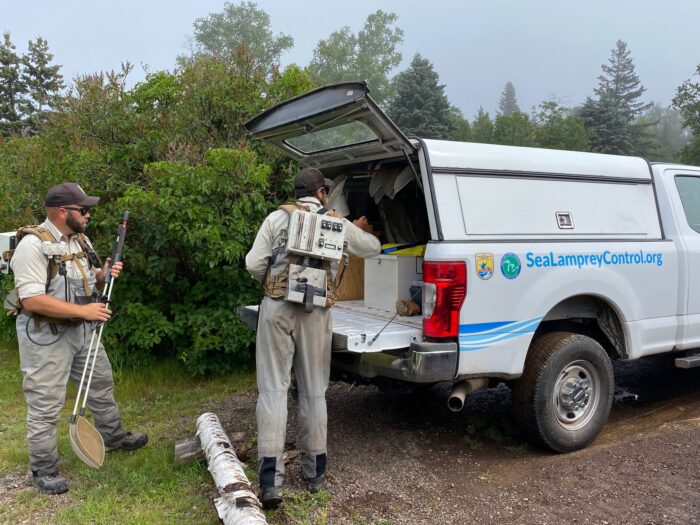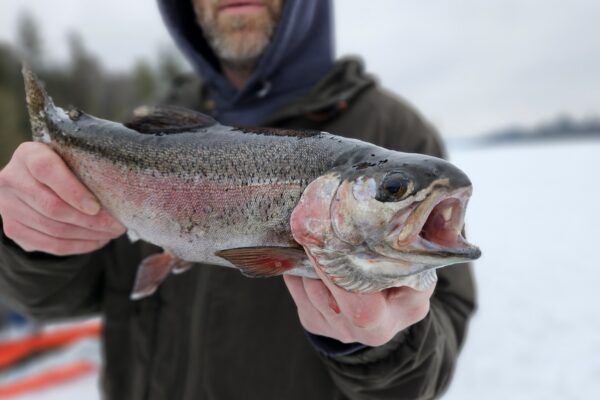Sea lamprey navigate North Shore rivers as reports of the invasive species increase in parts of Lake Superior
Nikolas Rewald has a tendency to feel resentment when a sea lamprey is found in a river along the North Shore.
“Yeah, I take it kind of personally,” he said.
A biologist with the U.S. Fish & Wildlife Service based in Marquette, Michigan, Rewald’s primary objective is to kill sea lamprey. He and another researcher with Fish & Wildlife, Michael Woodworth, were on the North Shore of Lake Superior in recent weeks conducting sea lamprey larval research at a collection of rivers from the Duluth area all the way to the Brule River at Judge Magney State Park. The team of researchers were looking for young lamprey in the Brule and other rivers along the North Shore, including the Knife River, to gather evidence of how many lamprey are spawning in these waters. For example, Rewald said they found three different year classes of sea lamprey this year in the Knife River near Two Harbors.
Sea lamprey are an eel-like fish that grow to be 12 to 20 inches long, according to the Minnesota Department of Natural Resources. Sea lamprey have a nightmarish quality to them, particularly their suction-cup like mouth packed full of teeth arranged in concentric circles.
Young sea lamprey live in streams or rivers, including places like the Poplar and Brule in the WTIP listening area, where they start their lives feeding on algae and existing as filter feeders.
Cory Goldsworthy is the Lake Superior Area Fisheries Supervisor for the DNR in Minnesota. He says a wet spring that washed out some of the rivers along the North Shore could impact sea lamprey spawning habitat this year and for years to come.
Sea lamprey larvae spend four to six years in the stream, where they exist in a less disturbing state, at least physically speaking, lacking teeth and eyes at this stage of life. They then transform into their parasitic phase and migrate into the open waters of Lake Superior to feed on fish for about 18 months. They feed like a vampire, sucking the blood from lake trout and other fish they manage to attach themselves to.
Rewald said most people are unfamiliar with the life cycle of sea lamprey, including people who live near or recreate on Lake Superior.
“Most people don’t even know they’re in the streams,” he said. “We deal with a lot of landowners and so many of them are just shocked that we pull lamprey out of the stream they’ve lived on their whole life. They’ve never seen them and didn’t know they were there.”
Cold water this year in Lake Superior, with the surface temperature hovering just above 40 degrees throughout most of the summer, is impacting the Fish and Wildlife Service’s ability to conduct certain lamprey control measures.
“We were supposed to do a bunch of that work this trip, but unfortunately the lake water is too cold this year. We can’t use the chemical. We need 12 degrees Celsius water and we’re getting single digits in most of our areas,” Rewald said.
Woodworth observed that most of the sea lamprey mitigation efforts take place on the South Shore of Lake Superior, in rivers in Wisconsin and Michigan that flow into the Big Lake.
Despite the cold water temperatures, the Fish and Wildlife sea lamprey control team were able to do research on the number of young lamprey in the Brule. On a recent Saturday morning, Rewald and Woodworth waded into the river equipped with gear they needed to find young lamprey burrowed in the sand or silty bottom of the river. Equipped with packs that look like something a ghostbuster might wear, the researchers zapped larvae with electrofishing gear. The devices have a basket on the end of a 4-ft. wand which send electric currents into the silt and stuns any sea lamprey hiding in the river bottom. A series of beeps from the pack on their backs indicates electricity is moving through the water.
News that young sea lamprey were discovered in a new section of the Knife River this year is not good news for the state, federal and international agencies who are trying to remove or at least greatly control the population in Lake Superior. Reports of lamprey scarring lake trout along the North Shore and waters near Isle Royale also has state and federal officials concerned.
To hear a full report from the Brule River and interviews with state and federal wildlife officials who work on lamprey control on Lake Superior, listen to the audio feature below.














